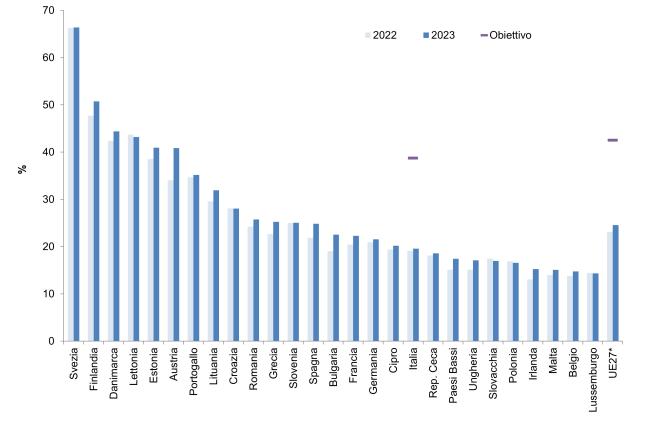Panel 1
Antonio Caputo
In Italy, the share of energy from renewable sources reached 20.4% of gross final consumption in 2020, exceeding the national target of 17%. In 2023, this share declined to 19.6%, remaining well below the 2030 target of 38.7%.
The indicator measures the share of energy from renewable sources in gross final consumption, and is based on the methodology established by Directive 2009/28/EC (Renewable Energy Directive) on the promotion of the use of energy from renewable sources for the years up to 2020 and on the methodology established by Directive (EU) 2018/2001 from 2021. It is calculated on the basis of data collected in the framework of Regulation (EC) No. 1099/2008 (amended by Regulation (EU) 2022/132) on energy statistics and supplemented by additional specific data transmitted by national administrations to Eurostat.
Evaluate the contribution of clean and non-exhaustible energy sources in final energy consumption, in order to increase their use.
Directive 2009/28/EC established national targets for the share of energy from renewable sources in gross final consumption by 2020 for each European Union Member State. These targets include energy from renewable sources used for electricity generation, heating and cooling, and transport. The Directive also provides for the possibility of concluding agreements on the statistical transfer of specified amounts of renewable energy between Member States, as well as for cooperation among them — or even with third countries — in the production of renewable energy.
Italy’s renewable energy consumption target for 2020 was set at 17% of gross final consumption. Legislative Decree No. 28/2011, implementing Directive 2009/28/EC on the promotion of the use of energy from renewable sources, defines the criteria for developing renewables primarily through incentive mechanisms and the simplification of authorization procedures.
As part of the European Green Deal, the EU updated its climate strategy by setting the objective of reducing greenhouse gas emissions by 55% by 2030 compared to 1990 levels, and by increasing the share of renewable energy to at least 42.5%, as established by Directive (EU) 2023/2413 (the so-called RED III). This new framework builds on the REPowerEU Plan adopted by the European Commission in May 2022 (COM(2022) 230), with the aim of reaching 45% renewables and achieving an improvement of at least 36% in energy efficiency — expressed as a reduction in final energy consumption — and at least 39% in primary energy consumption compared to the baseline (Primes 2007 model).
The measures necessary to achieve the objectives of the European Green Deal and REPowerEU were included in Italy’s National Recovery and Resilience Plan (NRRP), submitted to the European Commission in 2021, and subsequently integrated into the National Integrated Energy and Climate Plan (PNIEC), with a 2030 horizon, transmitted to the European Commission on 1 July 2024.
The national target for the share of energy from renewable sources in gross final consumption assigned to Italy by the PNIEC for 2030 is set at 38.7%.
Panel 2
Data quality assessment
EUROSTAT (Statistical Office of the European Communities)
EUROSTAT (Statistical Office of the European Communities) ( https://ec. europa. eu/eurostat/data/database )
National
2004-2023
Indicator assessment
Energy data are reported by Member States to Eurostat through the Annual Joint Questionnaires (Eurostat/IEA/UNECE). The calculations are carried out in accordance with the methodology established by Directive 2009/28/EC.
In 2023, the national share of energy from renewable sources amounted to 19.6% of gross final consumption (Table 1 and Figure 1), calculated according to the methodology established by Directive (EU) 2018/2001. This represents a slight increase of 0.5 percentage points compared to 2022. Italy’s target for 2030, as set out in the National Integrated Energy and Climate Plan submitted to the European Commission on 1 July 2024, is 38.7%.
The use of renewable energy in the EU27 has increased steadily, with the 2023 share more than doubling compared to 2004, when renewables accounted for 9.6% of gross final energy consumption. Between 2004 and 2020, the national share of renewable energy grew on average by 0.9 percentage points per year. In 2021, the share decreased by 1.5 percentage points compared to the previous year, followed by two years of growth: 0.2 percentage points in 2022 and 0.5 percentage points in 2023.
At the national level, the share of renewable energy has tripled since 2004, when renewables covered 6.3% of gross final energy consumption (Table 1 and Figure 1).
Data
Table 1: Share of Energy from Renewable Sources in Final Consumption for European Countries
EUROSTAT
-
Since 2020, data for the United Kingdom are not available in the Eurostat database, and EU figures refer to the EU27 for the entire time series; n.d. = not available.
Directive 2009/28/EC up to 2020; Directive (EU) 2018/2001 from 2021 onwards

In 2023, the national share of energy consumption from renewable sources reached 19.6%, marking an increase of 0.5 percentage points compared to the previous year. While the 17% target set for 2020 was exceeded, the 38.7% target for 2030 remains a long way off.
At the European level, the share of energy consumption from renewable sources reached 24.6% in 2023, up 1.4 percentage points from 2022 (Table 1 and Figure 1).